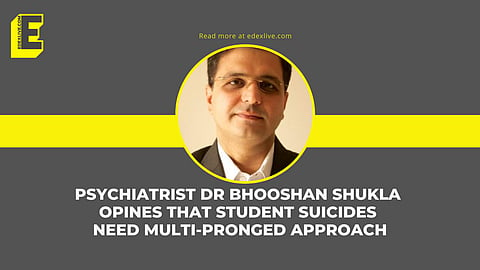

Just three months after Aditya Prabhu, a BTech student from Bengaluru's well-known PES University had jumped to his death from the college building, another student of the college died by suicide on October 27, Friday.
Surya M Achar, a third-year student pursuing BTech Computer Science from the Electronic City branch of the varsity ended his life by jumping from the college building.
When we draw parallels between the deaths of Aditya Prabhu and Surya Achar, as both died by jumping from their college buildings, Dr Bhooshan Shukla, children and adolescents psychiatrist, recollects a phenomenon called 'copy cat suicide' and explains, "People who are vulnerable or in similar situations might get triggered and use the same method," says Dr Shukla who is a visiting consultant at Smt Kashibai Navale Medical College in Pune.
Giving us more insights into this, the Pune-based psychologist says that using sleeping pills or such methods are usually ruled out because of the advances made in medical science. "Hanging, jumping from buildings or in front of railway tracks, these create very non-salvageable situations," he says.
But when we ask if those who live in hostels, cut off from friends, family and familiarity, tend to be more vulnerable to suicidal tendencies, he refutes the question and establishes, "In fact, those living with family might be more prone to mental health issues because it is even more tragic when you are surrounded by people and yet, have no one to speak to. So staying in hostels is not the issue."
Preventive measures
The main suicide prevention logic is that the student will not take the extreme step if people are around. "Public suicides are very rare," he says. So beginning by launching suicide helplines, approachable and accessible counsellors, destigmatisation of mental health coupled with other initiatives can help get to the root cause of the problem, he suggests.
But who is responsible and who should be taking up the responsibility? "There is an answer, but the society is not ready to accept it," he cautions as he proceeds.
Take for example Project Tiger, Dr Bhooshan Shukla, goes on to explain. "Just like the population of tigers is an indication of the health of the jungle, high suicide rates are indicative of an unhealthy society," the child and adolescent psychologist explains succinctly.
"Just like we can't expect a healthy number of tigers to thrive by allotting them a two-km radius urban jungle similarly, by launching just one or two mental health programmes, no university can solve the problem," he says, suggesting a long-term multi-pronged approach.
Screening tests for mental health problems or suicidal tendencies are a particular no because there tend to be several false positives, "Remember, several adults who die by suicide don't even have mental health problems," points out Dr Shukla who is also a part of Trimiti Clinic, which offers comprehensive child psychology services.
